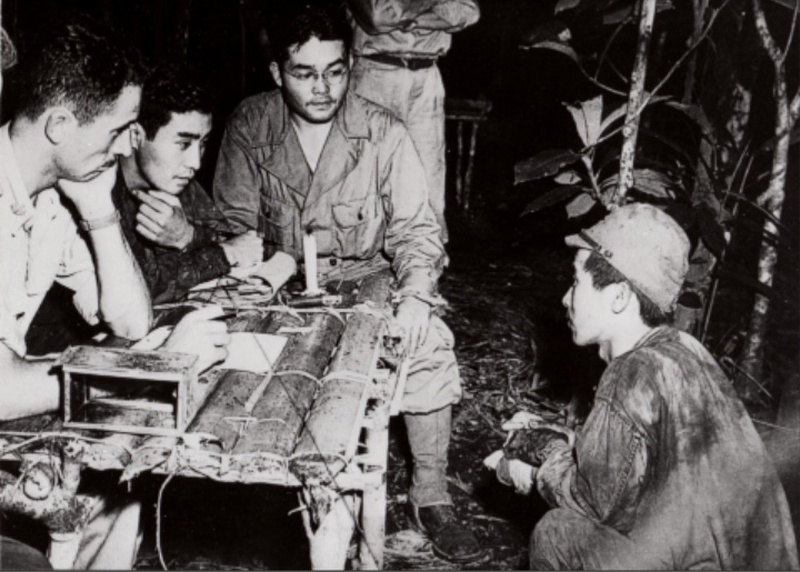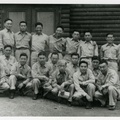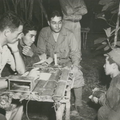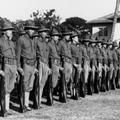South Pacific Area
Commanded by Admiral William Halsey, combat was centered on Guadalcanal, Bougainville and other parts of the Solomon Islands. Tonga, Fiji, Tahiti and New Caledonia, which were not occupied by Japan, served as Allied support bases. The following is an example of a skilled interrogator, Roy T. Uyehata, Gilroy, CA, as described by Dr. Stanley L. Falk and Dr. Warren M. Tsuneishi, MIS in the War Against Japan.
In February 1944, the U.S. 37th Infantry Division and the America Division of the XIV Corps fought the Japanese 6th Division from Kumamoto Prefecture. Uyehata interrogated a prisoner, who said he assumed the Americans knew the Japanese were planning to attack at dawn on March 23. Uyehata was not aware of this information and believed it was new. In an attempt to obtain maximum details in a natural setting, Uyehata pretended he knew the information and said he wanted to review it with the prisoner.
When he got the information he needed, Uyehata feigned a headache saying he needed to report to the medic. Uyehata instead reported this information to his commander, Captain William Fisher, who arranged the re-interrogation of another prisoner who had been cooperative. The intelligence information was confirmed and reported up the chain of command to the corps commander, General Oscar Griswold.
The night before the planned Japanese March 23 attack, U.S. forces launched a massive artillery bombardment from land and sea. Result: 5,000 enemy killed and 3,000 wounded. The U.S. suffered 263 casualties. Uyehata was awarded the Bronze Star Medal. Captain Fisher arranged for his own parents to make a goodwill visit to Uyehata’s parents at the Poston, AZ internment camp to tell them about their son’s contribution to victory.
South East Asia Command
Britain’s Lord Louis Mountbatten was the over-all commander with U.S. General Joseph Stilwell as Allied deputy commander and commander of U.S. forces. MIS Nisei linguists were involved with translating enemy documents and intercepted communications and broadcast propaganda. A smaller number were part of Office of Strategic Services (OSS) Detachment 101, which organized the Kachin tribesmen of northern Burma to harass Japanese forces and rescue downed Allied aircrew. When the Nisei asked one of the Kachin soldiers how many enemy soldiers he had killed, the Kachin emptied a bag containing dried human ears.
Merrill’s Marauders and its successor, the MARS Task Force, conducted special forces work behind enemy lines. Henry H. Kawabara led an MIS language team to work with the British Army and Eiichi Sakauye served with a British Gurkha glider force that captured Rangoon.
In May 1944, the 5307th Composite Unit -- Merrill’s Marauders -- achieved its goal of capturing the airfield at Myitkyina, an all-weather airport that was the gateway to the Burma Road which hauled war materiel to China. Fourteen Nisei linguists and team leader, 1st Lt William Laffin, who was killed in combat, served dual roles as linguists and riflemen.
One night, Roy Matsumoto, who attended high school in Japan, where he received student military training, crawled to the enemy bivouac area, eavesdropped on their discussions and reported to his battalion commander the enemy was planning a largescale attack at dawn. The commander prepared and waited.
The following morning a large Japanese force struck and fell into the trap. When the second wave hesitated, Matsumoto stood up and shouted in Japanese to charge. The Japanese did, to their peril. The third wave withdrew. The enemy sustained fifty-nine killed. Grant Hirabayashi, who attended high school in Japan and was allergic to Army K rations, survived on Army biscuits and occasional Japanese food left behind when Japanese soldiers fled in haste. He was evacuated before the Myitkyina attack due to jungle disease and malnutrition. Before the mission began its journey, the medic had recommended Hirabayashi be exempt from serving in the MM but Hirabayashi declined, determined to stay on a mission that War Department officials warned 85 percent of the men would not survive. With only 200 men left standing when Myitkyina fell, Merrill’s Marauders was deactivated and the MARS Task Force took over by defeating the last of Japanese military presence in the Lashio area.
China Theater
In China, five Nisei joined the Dixie mission to serve in the caves of Yan’an on the invitation of the Chinese communists. Sanzo Nozaka, Japan Communist Party (JCP) head in secret exile at Yan’an, arranged for MIS Nisei to interrogate captured Japanese soldiers.
Nozaka, who received newspapers from Japan within 10 days of publication, also provided psywar advice which was forwarded to the Nisei psywar unit. The irony of this cordial wartime relationship is that the JCP would become the No. 1 intelligence target of the U.S. Army Counterintelligence Corps during the Occupation of Japan.
One Nisei, accompanied by a Chinese communist escort, was sent on a mission to rescue a downed American pilot. The pilot was initially skeptical of the Nisei but grateful. The Americans were invited to the Chinese Communists’ Saturday night dances where they fraternized with Mao Tze-tung, Chou En Lai, Chu Teh and other Communist leaders.
This was the first U.S. government-to-government contact with the Chinese Communists. Immediately after Emperor Hirohito announced Japan’s surrender, OSS Nisei accompanied each OSS parachute missions to Japanese prisoner of war camps in China to ensure Allied POWs were not harmed by their Japanese captors and released as quickly as possible.
Invasion of Japan
The invasion of Okinawa began on April 1, 1945. MISers of Okinawan descent, who spoke the Okinawan dialect, volunteered to serve as a team in Okinawa. Many other Nisei linguists served in the climactic Battle of Okinawa, including nearly 200 who were assigned to civil affairs and medical units and sent directly there from Hawaii without undergoing training at the MISLS.
Others went with language teams assigned to each combat division. Takejiro Higa of Hawaii was part of the 96th Division’s ten-man language team. Higa had attended school in Okinawa and spoke the Okinawa dialect. He advised American officers about Okinawa, persuaded Okinawa civilians to leave the caves and surrender peacefully. Higa met some former school mates in one interrogation session and took a few moments to cry with them. Nisei entered caves to persuade Japanese soldiers and civilians to surrender. Having established an operating base on Japanese soil, Allied forces were about to mount the invasion of Kyushu when the A-bombs were dropped and Japan surrendered.
Occupation of Japan
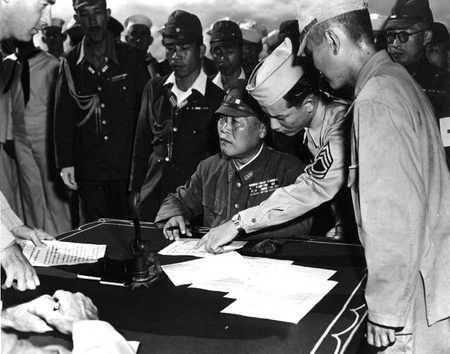
Following Japan’s surrender, Nisei, who just fought the Japanese, now worked peaceably with them to achieve Supreme Commander of Allied Powers (SCAP) MacArthur’s directive of building a democratic industrialized Japan allied to the Western world. This involved the demobilization of the Japanese armed forces, war crimes trials, and the occupation of Japan.
In addition to many of the Nisei who served in combat or overseas, some 2,000 additional Nisei, served during the occupation from the national to the local levels to ensure occupation policies were carried out. MacArthur’s orders were sent to the national government, which distributed them through the Japanese administrative system to the village level.
MIS representatives, like Peter Okada of Seattle, WA, who were assigned to SCAP’s education section at the village level made unannounced visits to schools to ensure photos of the Emperor and Empress were removed and martial arts training was discontinued. The youths were despondent. Okada, using his own time and resources, introduced American football to two high schools. This grew into a program involving 120 high schools in the Kinki and Tokyo regions.
Eventually, over 200 colleges and 100 company clubs also formed competitive American football programs. Okada was invited to Japan in 1992 to be honored at a midfield ceremony at the Nishinomiya Bowl as the father of American football in Japan. Emperor Hirohito commended the Nisei role in the Occupation.
In a meeting at the Imperial Palace, the Emperor told Major Kan Tagami, a MARS Task Force veteran and later an aide to General MacArthur: “Your Japanese ability has truly made the government’s work much easier. The Nisei are a bridge across our two countries. Thank you very much.”
As the internment camps closed at the end of the war, many internees settled in different parts of the nation; a number of them returned to their homes and businesses in the Pacific Coast states. Some local residents were openly hostile to their return, shooting into their homes, burning their warehouses and yelling epithets. Caucasian soldiers who served with the Nisei in the European and Pacific theaters, where they saw Nisei displays of courage, the use of actionable intelligence Nisei produced, and commitment to their nation, were among the Nisei greatest supporters.
Shawn P. Quinn, Manager, Stamp Development manager for the U.S. Postal Service, December 10, 2020 response to JAVA President Gerald Yamada’s letter about recognition for the MISers in the U.S. postage stamp that honors World War II Nisei soldiers and will be circulated in 2021 said, in part: “There will be occasions when we will have limited space [to name all deserved entities], but we will be sure to explain that soldiers who served as linguists and interpreters are included in this important group.”
Post War Developments
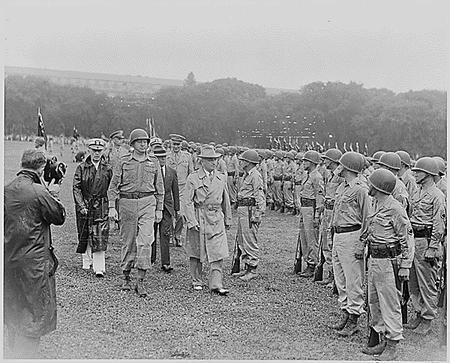
It rained hard in Washington, D.C. on July 15, 1946, the day President Harry Truman was scheduled to review the 442nd Regimental Combat Team. The military aide recommended Truman cancel his portion of the day’s event. Probably reminding himself he too fought in the rain in the Vosges during World War I, Truman replied, “hell no, for what these boys have done I can stand a little rain.” The MISers, who served equally courageously fighting against persons of their racial background, where brothers served on opposite sides, were there at the Ellipse in spirit that day to share the President’s remarks: “You fought not only the enemy, but you fought prejudice—and you have won”. Truman’s remarks resonated across the land supported by strong editorials. Through his remarks to the national audience and his presence that day, Truman 1) affirmed Japanese American loyalty, 2) removed from the table the stigma of disloyalty placed there when war began, and 3) placed Japanese Americans in the nation’s mainstream. In the aftermath of the Japanese attack on Pearl Harbor, President Roosevelt issued Executive Order 9066 that allowed the Army to imprison unconstitutionally 110,000 ethnic Japanese for the duration of World War II, although two-thirds of them were Americans by birth. Three years after the war President Truman, drawing inspiration from the Tuskegee Airmen, Navajo Code Talkers, Nisei soldiers and other minorities, issued Executive Order 9981 in 1948 which desegregated the armed forces and allowed minorities to compete for any job and rank in the military. The effects of this Executive Order were felt in the civilian sector as well. (E.O. 9981 is further explained in the JRT comment below.) In 1988 President Reagan offered the nation’s apology for the internment.
How Did MISers Do?
Nisei who served in the MIS should be judged on three points: (1) their loyalty and patriotism; (2) the value of the intelligence they produced; and (3) their role in the Occupation of Japan. As for the first point, the colonels who steadfastly attested to Japanese American loyalty, such as Colonel Moses H. Pettigrew of the Japan Branch at the War Department, and Colonel Kendall Fielder, intelligence officer to the military governors of Hawaii, must have been satisfied their judgment of the Nisei loyalty and patriotism was proved correct: No Japanese American was convicted for collaborating with the enemy or for disloyalty. As for the second point, Col. Kai Rasmussen, wartime commandant of MISLS, at the Presidio, Camp Savage and Fort Snelling, in a lengthy press release issued on 22 October 1945, said, “never before in history did one army know so much concerning its enemy prior to actual engagement as did the American army during most of the Pacific campaign.” Dr. James McNaughton, while on the staff of the Army Center of Military History, responded to JAVA’s query on February 5, 2007 that some writers have erroneously attributed this quote to General MacArthur. As for the third point, The Emperor expressed to an officer of MacArthur’s staff Japan’s appreciation for the Nisei role in the Occupation.
* * * * *
JAVA Research Team (JRT) Comment: Executive Order 9981 said, “there shall be equality of treatment and opportunity for all persons in the armed forces without regard to race, color, religion or national origin.” Responsibility for content and presentation is JRT’s. Sources most helpful for the preparation of this paper were Dr. James McNaughton, Nisei Linguists: Japanese Americans in MIS During WW II; MIS Veterans Hawaii booklet The Nisei Intelligence War Against Japan, 1993; NJAHS booklet The Pacific War and Peace, 1991 from which the reference “eyes and ears” was taken; and JAVA’s Falk and Tsuneishi’s American Patriots: MIS in the War Against Japan, 1995
*This article was originally published in the JAVA e-Advocate on February 4, 2021.
© 2021 JAVA Research Team


